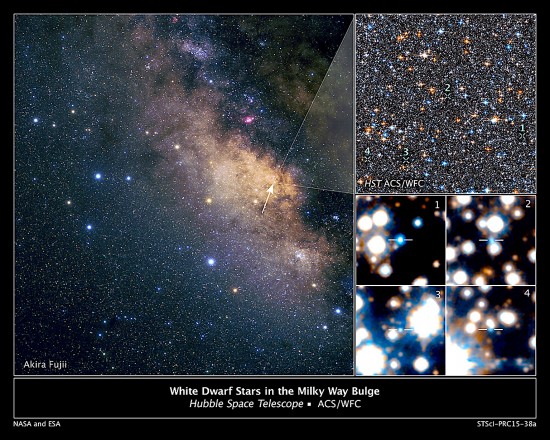Nov 18, 2015
How are stars and galaxies born?
The Milky Way is thought to harbor nearly a trillion stars in orbit around its central gravity source. According to cosmologists, our galaxy condensed out of a cloud of hydrogen and dust thousands of light-years wide, with a more-or-less homogeneous blend throughout.
Gas and dust collapsed as gravity pulled matter into a compression zone. Eddies formed, creating an extremely hot, dense sphere. Once temperature and pressure reached a critical point, hydrogen fusion ignited in the primordial galactic core and it began to radiate.
The initial cloud was an undifferentiated mass, as the theory states. Stars in proximity to the Sun should all be cut from the same cloth and contain similar chemical constituents. However, observations in a hundreds of light-years-wide shell, including the nearest 6000 stars, reveal that they are all different from one another: some with too much helium, some with too much iron, etc.
Stellar evolution is said to progress along a well-established path that involves fusion reactions forming ever heavier elements until hydrogen is consumed and radiated away. The star’s core becomes “choked” with heavy elements. Once iron is synthesized no more fusion can take place, causing the star to implode, throwing off its outer layers. Less massive stars gradually darken into cool, red shadows of their former glory. Since a star’s age is conventionally determined by its temperature and luminosity, the Sun’s neighbors are thought to be different ages, varying to such an extent that astronomers think they were not even born in the same place or at the same time.
For example, as written previously, the ten stars within 11 light-years of the Sun exhibit unique characteristics:
Star Name Distance
Proxima Centauri 4.2 light-years
Rigil Kentaurus 4.3 light-years
Barnard’s Star 5.9 light-years
Wolf 359 7.7 light-years
Lalande 21185 8.3 light-years
Sirius A and B 8.6 light-years
Luyten 726-8 A and B 8.7 light-years
Ross 154 9.7 light-years
Ross 248 10.3 light-years
Epsilon Eridani 10.5 light-years
Each star is different from the Sun and they are different from each other. Ross 248 is a red dwarf star, while Sirius A is a main sequence star twice the Sun’s mass. Although a few stars are similar to Proxima Centauri and Ross 248, their elements are distributed differently in each one, as spectrograms reveal.
Astronomers working with the Hubble Space Telescope think that they are solving some of the most pressing questions about galaxy formation and evolution. Using Hubble to analyze the Milky Way’s bulge, they found “…a population of superdense stellar corpses called white dwarfs…archeological evidence of the first few billion years of the galaxy’s history.”
According to lead author Annalisa Calamida, of the Space Telescope Science Institute (STScI):
“The Milky Way’s bulge includes almost a quarter of the galaxy’s stellar mass. Characterizing the properties of the bulge stars can then provide important ways to understand the formation of the entire Milky Way galaxy and that of similar, more-distant galaxies.”
Why the stars should be so unalike is a mystery to astronomers since they should have the same mix of elements from their nebular nursery. One previously proposed solution is that the spiral arms of the Milky Way appear and disappear over the eons. The Solar System is said to take about 250 million years for one revolution around the center of the galaxy, and during that time it might have felt a push or a pull from one or another of the arms—ahead of the star an arm might impart a gravitational push, accelerating it farther away from the galactic center of gravity. Conversely, behind a spiral arm, it might have been pulled into a lower orbit.
Annalisa Calamida: “These results suggest that the environment in the bulge may have been different than the one in the disk, resulting in different star-formation mechanisms.”
Galactic and stellar evolution due to accretion and gravity, furnaces in stellar cores, data compiled from stellar brightness and color, and gravitational acceleration by congregations of loose-knit spiral arms have all been vigorously opposed by Electric Universe physicist Wal Thornhill’s electric explanation of stars and galaxies. By not bringing the electrical interaction of stars with their galactic environment into the picture, an entire line of investigation is never considered.
Astronomers and other specialists are not mapping the electric charge flowing through space in order to determine its influence on stellar evolution. Because of that oversight, they constantly overstate the gravitational model of the cosmos.
Retired Professor of Electrical Engineering Dr. Donald Scott wrote that the absolute brightness of a star depends on the strength of the current density impinging into its surface, along with the star’s diameter. As current density increases the star becomes hotter and brighter, glowing bluer and whiter. If charge flow into a star decreases, it becomes red and cools down. So using magnitude and color to determine a star’s age is a false premise.
In plasma cosmology and cosmogony, stars form in galaxy-spanning Birkeland currents. Such currents actually draw charged material along their filaments from across vast distances in space. As two (or more) filaments begin to twist around one another because of a long-range attractive force, z-pinch effects crush plasma into galaxy-shaped masses.
In consideration of the work done by Wal Thornhill and Donald Scott, variations in stellar chemistry, as well as their velocity differences, are better explained by a plasma hypothesis. It is electrical forces active in space and not gravitational shuffling that causes differences among the stars.
Stephen Smith













